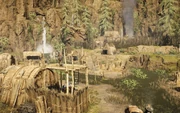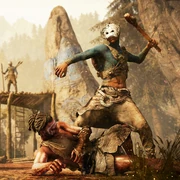Far Cry Primal Easy Way to Kill Batari
![]()
| « | Sun walkers cage Wenja, use them like tools. Worse than death. | » |
| Tensay | ||
The Izila tribe (His-hílax, "the language of the masters"[1]), also known as the Sun Walkers (Sushalhayn), are an antagonistic tribe of fire masters from Mesopotamia led by their matriarch Batari and commander Roshani that reside in the Southern Marshlands of Oros in Far Cry Primal. They are one of the main antagonists in the game, enslaving the Wenja and the Udam for labor and sacrificing them to their deity of the sun, Suxli. Their technology is much more advanced than the other tribes, and their equipment stronger. They live in well-defended agrarian settlements scattered across the south of Oros.
Description

An Izila settlement
The Izila are an advanced, Aztec-like pyromaniacal tribe of Homo sapiens doomsday cultists who originated from Mesopotamia before spreading north into Central Europe and the Valley of Oros.[2] They worship their High Priestess, Batari, as a matriarch, believing her to be a living embodiment of the heavens due to her birth during totality in a solar eclipse on the summer solstice. They also heavily sacrifice both people and animals to appease their deities; Suxli and Mensos, the sun and the moon, respectively. In contrast to the Neanderthal Udam, the Izila are modern-day Homo sapiens (humans). They are fitter, taller, more athletic, and relatively skinnier compared to the other tribes, making sense because of their species difference. The language of the Izila is different, but similar, to that of the Wenja and the Udam. It is much more complex and advanced, sounding similar to Proto-Indo-European, making use of extensive verb conjugation, pitch registers, and noun classes that change depending on object animacy. All Udam and most Wenja are considered inanimate in the eyes of the Izila, unworthy of being referred to as a person.[3]

An Izila warrior brutally capturing Wenja
The Izila have a very unique culture, building standing stones and burial barrows all over central and southern Oros, in stark contrast to the primitive Wenja and Udam structures. The Blajiman Stones, located on the southern slopes of a large central mountain, are the most famous of these, resembling the Stonehenge built a few millennia later in present-day England. The Izila make use of fire in their warfare and have mastered how to control fires to burn down enemy villages. Also notable is their matriarchal society/culture, which makes them unique from other tribes.
Izila thinkers have created a self-sustaining agrarian society after discovering advanced farming and irrigation to grow their own food. Batari, their leader, supports her people above all others. She started the tradition of sacrificing Wenja to the sun goddess Suxli, believing that the spilling of their blood would make the crops more bountiful. Being far more technologically developed than the Wenja and the Udam, their territory in the south of Oros is marked by their larger shelters and actual buildings. The Izila's formidable architecture is evident when visiting Izila outposts and forts, most notably their base of operations, Fire Screamer Fort. They are all more organized than the outposts of the Udam. Using wood, hay, and animal skins the Izila build villages of what resembles Iroquois longhouses. Their obsession with fire is ironic in this case, because many of their settlements have been burned down by the Udam, for their choice of building with wood and hay makes their structures easily flammable. The Izila do not usually make homes out of rock, but using the Wenja and Udam as slave labor, they force them to construct their famous standing stones.
The Izila have a very unique and advanced culture. They are a neolithic modern tribe with more advanced technology and evolution with worship of deities, slavery, barriers, agriculture and human territory markings.
The Izila usually use standing stones (aka Menhir) for barriers as well as territory markings, and speaking of which, masks worn by previous sacrifices called "IZILA MASKS" also mark Izila territory. They are usually placed on cliffs and rocks and mountains. The Fire Screamer Fort is by far the most populous Izila village with an estimated over 50-70 Izila soldiers residing there. This is because the fort is right next to the Izila Homeland, their main residing place and the seat of Batari's power.
The Udam and Wenja are mesolithic tribes with a simple primal culture. The Izila tribe on the other hand is a neolithic tribe with more of a unique indo-tribal culture with tribal chants, music and rituals. The rituals are usually held near Standing Stones in Izila territory where they sacrifice Wenja to their high priestess, Batari and their deites, Suxli and Mensos.
The Wenja seem to have learned from the Izila about their culture and have also started building more advanced structures and territory markings. The Wenja have "Wenja Bracelets" as territory markings and also have huts and diverse camps scattered across Oros.
The Izila are very new to Oros as they originally arrived from Mesopotamia and then part of the tribe set off to the Marshlands of Oros.
The Izila have a unique agricultural land, with remote fields and marshlands. They live in a very peaceful place where the temperature is very warm.
Warfare

Batari, matriarch of the Izila, above a bonfire of sacrificed Wenja and Udam
The skilled, agile and violent Izila warriors cover themselves in blue body paint to symbolize their worship of the celestial bodies of the sky, the sun and the moon (Suxli and Mensos). They are much more difficult for the Wenja to fight against compared to the Udam because of how much more advanced their technology is, and because their physique is better built for fighting. The Izila capture those who survive their attacks, to be sacrificed in their large bonfires, usually at the Mash Baya Rocks.[4] Compared to the warriors of the Udam, the Izila are much better-armed and hunt in larger groups. They make better use of their equipment as well; Izila Spearmen will relentlessly bombard enemies with spears,[5] using them to their full advantage, unlike the Udam, who prefer to charge. Izila also always employ their female combatants as archers.
The Izila are most notable for their use of fire in their warfare. Izila Scourge throw fire bombs, while Izila Chieftains throw burning clubs at their opponents. They themselves have developed a strong resistance to being burned. The Izila have mastered how to control their fires, ensuring that they do not get out of control and burn down their own settlements. They are quick-headed and sometimes difficult to attack in battle, jumping and doing ninja rolls to dodge. They enslave members of other tribes and sacrifice them in shamanic rituals, violently attacking anyone who attempts to stop them.
Many Izila wear armor made of stone and masks made of clay to protect themselves from their foe's weapons, also preventing them from being burned in case a fire goes awry. The Izila have a violent history with the Wenja and the Udam tribes, being the ones who gave Ull his burns and scars. They believe themselves to be above all other tribes and species of hominids and find it the way of the deities that all else be inferior. Because of this, Izila warriors are ruthless and pledge no allegiance to anyone but themselves.
Notable Members

Roshani, commander of the Izila forces, being held at spearpoint by Takkar, warrior of the Wenja
- Batari (Leader and High Priestess)
- Roshani (Commander)
- Krati (Warrior)
Units

An Izila archer
- Chieftains
- Scourges
- Spearmen
- Archers
- Hunters
- Slingers
- Warriors
Trivia
- "Izila" is only what the Wenja and the Udam call them. The Izila call themselves "His-hílax", or the masters. This relates to their belief that they are superior to all other tribes of hominids.
- The language of the Izila is very similar to reconstructed Proto-Indo-European, only being slightly simplified for easier pronunciation.
- The Blajiman Stones, built by the Izila in southern Oros, are a possible Easter egg to Stonehenge. They look very similar and fulfill the same purposes, with the sun aligning perfectly with the stones. In-game, the stones are used for sacrificial purposes.
- The Izila are likely inspired by various real-life neolithic farming tribes which begun migrating from the south-eastern Mesopotamian region into southern and central Europe around 11,000 years ago. These people mixed with the early European modern humans (Wenja) and present-day European populations have ancestry from both these groups.[6]
References
Source: https://farcry.fandom.com/wiki/Izila
0 Response to "Far Cry Primal Easy Way to Kill Batari"
Post a Comment